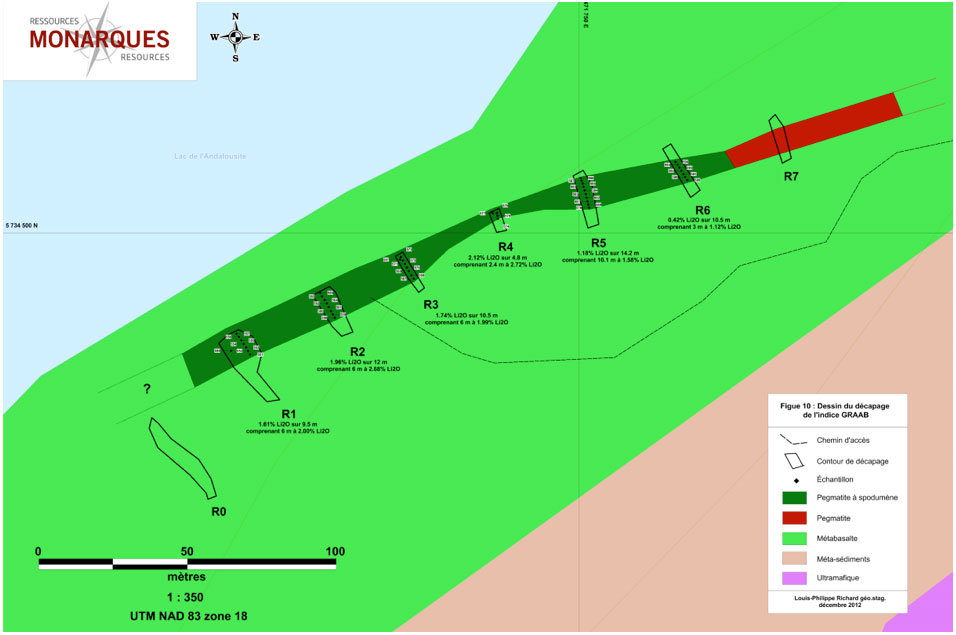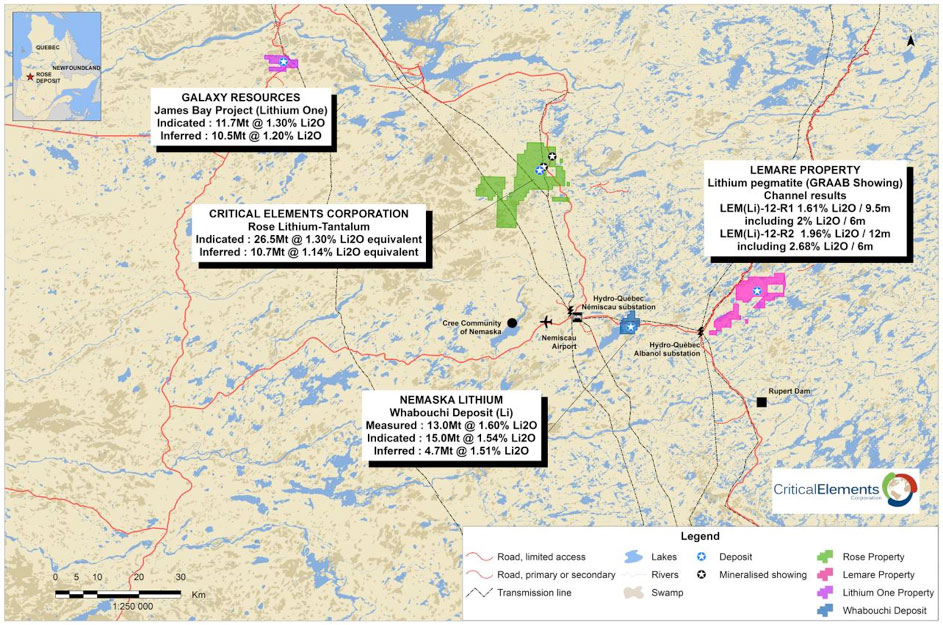February 11, 2016 – Montreal, Quebec – Critical Elements Corporation (“Critical Elements” or the “Company”) (TSX-V: CRE) (US OTCQX: CRECF) (FSE: F12) is pleased to announce that Critical and Lepidico Ltd (“Lepidico”) has entered into a binding agreement (“Agreement”) that gives the right to Lepidico to acquire up to a 75% interest in the Lemare lithium project.
Terms of the transaction
Under the Agreement, Lepidico will earn its interest in Lemare by way of a farm-in arrangement. The key terms of the Agreement are detailed in the table below:
| Conditions |
|
| Upon exercise of right to farm-in post due diligence |
|
| Earn 50% interest |
|
| Earn additional 25% interest (total 75%) |
|
| Royalty |
|
| Milestone Payment |
|
The Lemare project consists of 158 claims for a total ground position of 7,433 hectares (74 km2) in a region of Quebec that boasts other lithium deposits and known lithium mineralisation, as shown in the maps and table below. The Lemare project is potentially a new lithium field in an established lithium district.
Table 1. Lithium resources of the James Bay area.
| Company | Project | Measured & Indicated | Inferred | Sources |
|---|---|---|---|---|
| Nemaska Lithium | Whabouchi | 13.0Mt measured @ 1.60% LI2O and 15.0Mt indicated @ 1.54% LI2O | 4.7Mt @ 1.51% LI2O | NI 43-101 Technical Report - Feasibility Study on the Whabouchi Lithium Deposit and Hydromet Plant (Revised), prepared by Met-Chem Canada Inc., revision date January 22nd, 2016 |
| Critical Elements | Rose Lithium-Tantalum | 26.5Mt indicated @ 1.30% LI2O equivalent | 10.7Mt @ 1.14% LI2O equivalent | Technical Report and Preliminary economic assessment on the Rose Tantalum-Lithium Project, prepared by Genivar, December 10th 2011 |
| Galaxy Resources | James Bay | 11.7Mt indicated @ 1.30% LI2O | 10.5Mt @ 1.20% LI2O | Mineral Resource Evaluation James Bay Lithium Project, James Bay, Quebec, Canada, prepared by SKR Consulting, December 30, 2010 |
Figure 1. Location of known lithium deposits in the James Bay area of Quebec.

In October 2012, Monarques collected 43 channel samples from six trenches totalling 62 metres in length across the exposed spodumene pegmatite. Of these, 11 samples returned a LI2O content superior to 2%. The results of the channel sampling are shown in the table below:
Table 2. Channel sampling results from Lemare (Monarques Resources Inc.)
| Channel | Grade LI2O % | Length (metres) |
|---|---|---|
| LEM(Li)-12-R1 | 1.61 | 9.5 |
| including | 2.00 | 6.0 |
| LEM(Li)-12-R | 1.96 | 12.0 |
| including | 2.68 | 6.0 |
| LEM(Li)-12-R3 | 1.74 | 10.5 |
| LEM(Li)-12-R4 | 2.12 | 4.8 |
| LEM(Li)-12-R5 | 1.18 | 14.2 |
| including | 1.58 | 10.1 |
| LEM(Li)-12-R6 | 0.42 | 10.5 |
| including | 1.12 | 3.0 |
Initial exploration at Lemare was undertaken in 2012 by Monarques Resource Inc. who discovered a “granite pegmatite dyke containing a considerable amount of spodumene.” The pegmatite ranges in apparent thickness from 4.8 to 14.2 metres and was followed for close to 200 metres in length on surface. The full length of the dyke remains unknown and is open in both directions. The pegmatite is undrilled so the depth extent also remains unknown.
Figure 2. Trenching program at Lemare showing the six trenches channel sampled

Figure 3. Location of the Lemare project claims in the James Bay area, Quebec, Canada.

Outside of this trenching program, there has been limited lithium exploration undertaken at Lemare. Based on other lithium deposits around the world, it is a common occurrence for pegmatites to exist in “swarms.” As part of the due diligence process, Lepidico and Platypus will assess the potential for other pegmatites to exist within the project area.
“Lemare is a significant landholding that is highly prospective and sits in a proven lithium district, and boasts a large pegmatite that is ready to be drilled,” stated Gary Johnson, Chairman, Lepidico.
“The arrangement with Lepidico allows Lemare to advance towards resource delineation and project development over its other properties. Critical Elements is currently focussed on the development of its Rose lithium project. With Lepidico farming into the Lemare project, shareholders of both companies will be able to benefit from successful exploration of a highly prospective project,” stated Jean-Sébastien Lavallée, President and CEO, Critical Elements.
Jean-Sébastien Lavallée (OGQ #773), geologist, shareholder and President and Chief Executive Officer of the Company and a Qualified Person under NI 43-101, has reviewed and approved the technical content of this release.
Lepidico and Platypus
On February 1, 2016. Lepidico and Platypus entered into an exclusive agreement to complete mutual due diligence for the purpose of investigating whether or not an agreement for the acquisition by Platypus of Lepidico or its assets can be agreed.
Platypus Managing Director Tom Dukovcic said, “The Lemare acquisition is another prospective opportunity for Lepidico that we will consider as part of our due diligence. Platypus has undertaken to assist Lepidico in the assessment of Lemare and we are fully supportive of the potential acquisition as it would deliver a quality project to the growing portfolio.”
About Lepidico
Lepidico is a lithium exploration company and the 100% owner and licensor of the L-Max technology, a proprietary process which has the potential to commercially extract lithium and other by-products from unconventional sources at a competitive cost.
Currently, the majority of the world’s lithium is produced from either brines or hard rock spodumene. L-Max delivers an opportunity to create a third supply source of lithium, namely lithium bearing micas such as lepidolite and zinnwaldite. Although there are a number of known deposits of lithium bearing micas around the world, these materials have typically been overlooked as a source of lithium as there has been no commercial process available to economically extract the contained lithium and produce lithium carbonate or lithium hydroxide that is suitable for end users.
As part of its exploration activity, Lepidico has commissioned and received several geological reports to assist in the identification of ore bodies that have the potential to host commercial quantities of lithium bearing micas and associated lithium minerals.
With the use of its L-Max technology, Lepidico is seeKing to unlock the potential value of such lithium bearing micas. Lepidico is actively exploring opportunities to apply L-Max directly to:
- Brownfields Projects: There are existing mining projects around the world that currently have lithium bearing micas being passed through to waste dumps or tailings dams. Lithium bearing micas can be effectively concentrated by flotation, which would allow the L-Max process to be utilised to produce lithium products (and other by-products) from a source that has previously been deemed to be of no value.
- Greenfields Projects: There has been limited exploration to date relating to identifying deposits of lithium bearing micas. These micas typically occur in pegmatites (coarse grained granites), often in association with other lithium, tin or Tantalum containing ores.
Lepidico was founded in February 2015 by Executive Chairman Gary Johnson and has achieved significant progress in a short period of time. Gary Johnson is a metallurgist and has over 35 years experience in the mining industry in various roles. Gary currently is the Owner and Principal of Strategic Metallurgy Pty Ltd, which specialises in providing metallurgical and strategic consulting to various mining companies, including Sirius Resources, which Strategic Metallurgy has been involved with since first drill core. Gary was also the former Managing Director of Norilsk Nickel Australia and was a key proponent in the development and commercialisation of Activox®, a process technology for treating refractory gold ores and nickel sulphide concentrates.
About Critical Elements Corporation
A recent financial analysis (Technical Report and Preliminary Economic Assessment (PEA) on the Rose lithium-Tantalum Project, Genivar, December 2011) of the Rose project based on price forecasts of US$260/kg ($118/lb) for Ta2O5 contained in a tantalite concentrate and US$6,000/t for lithium carbonate (Li2CO3) showed an estimated after-tax Internal Rate of Return (IRR) of 25% for the Rose project, with an estimated Net Present Value (NPV) of CA$279 million at an 8% discount rate. The payback period is estimated at 4.1 years. The pre-tax IRR is estimated at 33% and the NPV at $488 million at a discount rate of 8%. (Mineral resources are not mineral reserves and do not have demonstrated economic viability). (The preliminary economic assessment is preliminary in nature). (See press release dated November 21, 2011.)
The conclusions of the PEA indicate the operation would support a production rate of 26,606 tons of high purity (99.9% battery grade) Li2CO3 and 206,670 pounds of Ta2O5 per year over a 17-year mine life.
The project hosts a current Indicated resource of 26.5 million tonnes of 1.30% LI2O Eq. or 0.98% LI2O and 163 ppm Ta2O5 and an Inferred resource of 10.7 million tonnes of 1.14% LI2O Eq. or 0.86% LI2O and 145 ppm Ta2O5.
FOR MORE INFORMATION:
Jean-Sébastien Lavallée, P.Geo.
President and Chief Executive Officer
819-354-5146
www.cecorp.ca
Investor Relations:
Paradox Public Relations
514-341-0408
Neither the TSX Venture Exchange nor its Regulation Services Provider
(as that term is defined in the policies of the TSX Venture Exchange)
accepts responsibility for the adequacy or accuracy of this release.